Intel SSD 520 Review: Cherryville Brings Reliability to SandForce
by Anand Lal Shimpi on February 6, 2012 11:00 AM ESTAnandTech Storage Bench 2011
Last year we introduced our AnandTech Storage Bench, a suite of benchmarks that took traces of real OS/application usage and played them back in a repeatable manner. I assembled the traces myself out of frustration with the majority of what we have today in terms of SSD benchmarks.
Although the AnandTech Storage Bench tests did a good job of characterizing SSD performance, they weren't stressful enough. All of the tests performed less than 10GB of reads/writes and typically involved only 4GB of writes specifically. That's not even enough exceed the spare area on most SSDs. Most canned SSD benchmarks don't even come close to writing a single gigabyte of data, but that doesn't mean that simply writing 4GB is acceptable.
Originally I kept the benchmarks short enough that they wouldn't be a burden to run (~30 minutes) but long enough that they were representative of what a power user might do with their system.
Not too long ago I tweeted that I had created what I referred to as the Mother of All SSD Benchmarks (MOASB). Rather than only writing 4GB of data to the drive, this benchmark writes 106.32GB. It's the load you'd put on a drive after nearly two weeks of constant usage. And it takes a *long* time to run.
1) The MOASB, officially called AnandTech Storage Bench 2011 - Heavy Workload, mainly focuses on the times when your I/O activity is the highest. There is a lot of downloading and application installing that happens during the course of this test. My thinking was that it's during application installs, file copies, downloading and multitasking with all of this that you can really notice performance differences between drives.
2) I tried to cover as many bases as possible with the software I incorporated into this test. There's a lot of photo editing in Photoshop, HTML editing in Dreamweaver, web browsing, game playing/level loading (Starcraft II & WoW are both a part of the test) as well as general use stuff (application installing, virus scanning). I included a large amount of email downloading, document creation and editing as well. To top it all off I even use Visual Studio 2008 to build Chromium during the test.
The test has 2,168,893 read operations and 1,783,447 write operations. The IO breakdown is as follows:
| AnandTech Storage Bench 2011 - Heavy Workload IO Breakdown | ||||
| IO Size | % of Total | |||
| 4KB | 28% | |||
| 16KB | 10% | |||
| 32KB | 10% | |||
| 64KB | 4% | |||
Only 42% of all operations are sequential, the rest range from pseudo to fully random (with most falling in the pseudo-random category). Average queue depth is 4.625 IOs, with 59% of operations taking place in an IO queue of 1.
Many of you have asked for a better way to really characterize performance. Simply looking at IOPS doesn't really say much. As a result I'm going to be presenting Storage Bench 2011 data in a slightly different way. We'll have performance represented as Average MB/s, with higher numbers being better. At the same time I'll be reporting how long the SSD was busy while running this test. These disk busy graphs will show you exactly how much time was shaved off by using a faster drive vs. a slower one during the course of this test. Finally, I will also break out performance into reads, writes and combined. The reason I do this is to help balance out the fact that this test is unusually write intensive, which can often hide the benefits of a drive with good read performance.
There's also a new light workload for 2011. This is a far more reasonable, typical every day use case benchmark. Lots of web browsing, photo editing (but with a greater focus on photo consumption), video playback as well as some application installs and gaming. This test isn't nearly as write intensive as the MOASB but it's still multiple times more write intensive than what we were running last year.
As always I don't believe that these two benchmarks alone are enough to characterize the performance of a drive, but hopefully along with the rest of our tests they will help provide a better idea.
The testbed for Storage Bench 2011 has changed as well. We're now using a Sandy Bridge platform with full 6Gbps support for these tests.
AnandTech Storage Bench 2011 - Heavy Workload
We'll start out by looking at average data rate throughout our new heavy workload test:
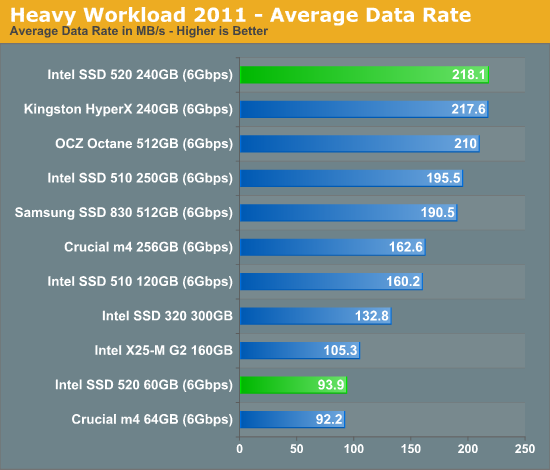
SandForce has always done well in our Heavy Workload test, and the 520 is no different. For heavy multitasking workloads, the 520 is the fastest SSD money can buy. Note that its only hindrance is incompressible write speed, which we do get a hint of in our breakdown of read/write performance below.
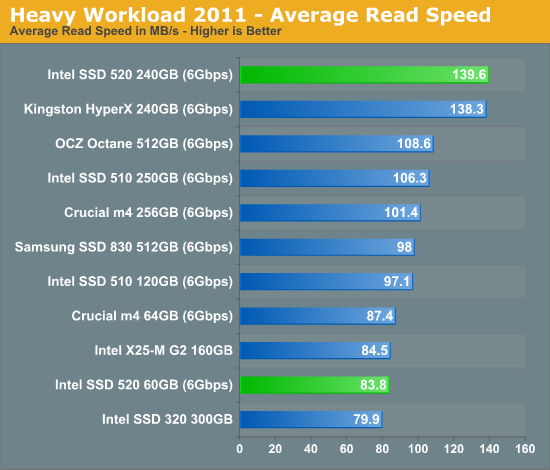
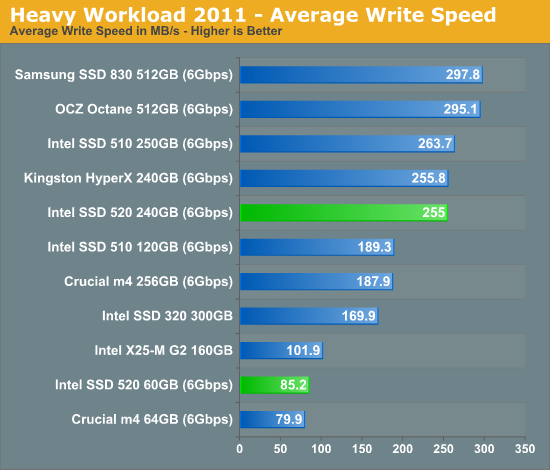
The next three charts just represent the same data, but in a different manner. Instead of looking at average data rate, we're looking at how long the disk was busy for during this entire test. Note that disk busy time excludes any and all idles, this is just how long the SSD was busy doing something:
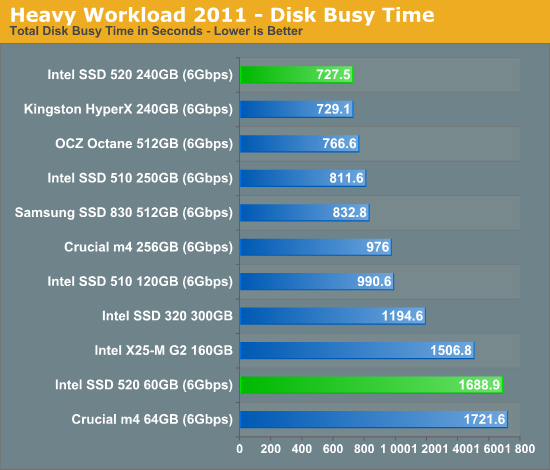
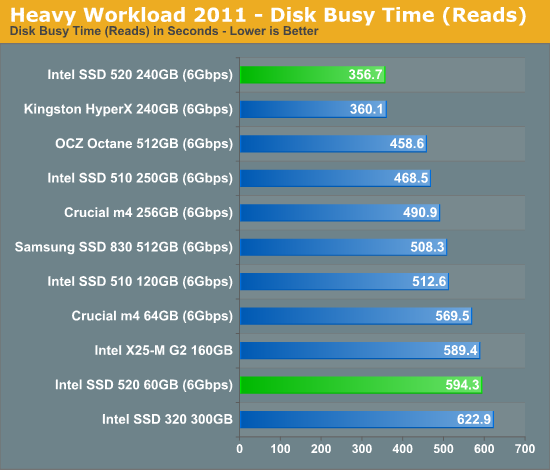
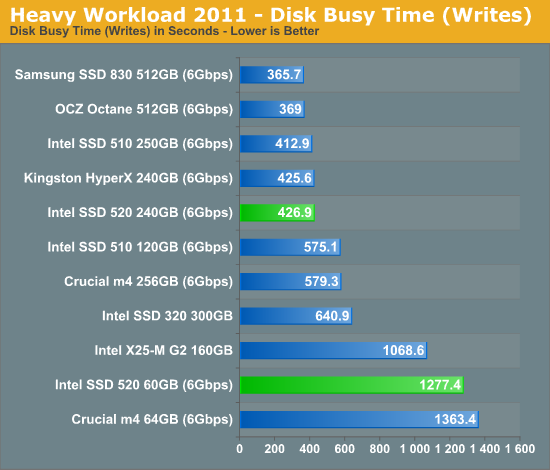










138 Comments
View All Comments
Iketh - Monday, February 6, 2012 - link
That price premium is doing me in, plus the irrecoverable drive thrashing. The 240gb Samsung will be my next purchase.Galcobar - Monday, February 6, 2012 - link
Find yourself having to ship a less reliable drive back to the manufacturer and the price premium disappears. At that point, not having to deal with the downtime and inconvenience of reinstallation is all gravy.Shadowmaster625 - Monday, February 6, 2012 - link
These drives are all built to pretty much the same physical quality standards. Firmware might be a different story, but for firmware it usually doesnt require a trip to the factory. Do you have any evidence to suggest that the physical build quality of an OCZ Vertex 2 is less than an Intel X-25?hackztor - Monday, February 6, 2012 - link
I had a vertex 1 that I had to ship back 4 times, finally I asked for a newer model. Got back the vertex 2. That right there is what Galcobar was talking about. Each time shipping is usually 10 bucks and about 2 weeks turn around time. Sometimes higher premium for better tested parts is worth the extra cost.pc_void - Monday, February 6, 2012 - link
The key word is sometimes.And sometimes you pay a higher price and have the same thing happen.
However, you can make an educated guess based upon lots of research. It still doesn't mean it won't happen.
Flunk - Monday, February 6, 2012 - link
I don't think firmware alone is responsible for the much lower failure rates of Intel SSDs over say... OCZ.I'm not saying other brands are bad, my Vertex 2 is still going strong with no issues, but these SSDs are built a little bit better than OCZ's drives and most of the other competition.
coder543 - Tuesday, February 7, 2012 - link
It's widely known that non-Intel SSDs have reliability issues. Recently they've gotten much better, but they still aren't yet comparable.taltamir - Monday, March 26, 2012 - link
The issue is that there are firmware bugs that intel fixed that sandforce and its other partners do not.You are right that there is no need to ship it back to the manufacturer... because they CANNOT fix it. A replacement drive will have the same bugs.
Your only recourse is to live with the bugs and BSODs or sell it second hand and buy an intel.
dmprok - Sunday, April 1, 2012 - link
I got Intel X-25 80Gb drive that failed on me TWICE in one year and I lost data. I picked Intel for TRIM function and because it was highly rated. First drive was purchased for $280 by my friend and it failed on him in 2 weeks, I thought he was doing something wrong, I bought dead drive from him and RMA'ed. It failed again for me in 6 months, one day computer just would not boot, I send it to RMA and got my 3rd drive, I hesitated to install for few months because I lost all faith in Intel SSD drives. I am not a heavy user, I don't run my PC 24/7, also the last drive drive I received does not look like quality made at all, the top of the drive is warped, I am disappointed, considering getting new Sandisk SSD for next upgrade.nsanity - Tuesday, February 7, 2012 - link
Having to ship a drive back means *absolutely nothing*. Hell, having to buy a complete new drive means nothing. The lost productivity when a business who has used a pair of SSD's as a shortcut to IOPS, as the machine BSOD's or drops an array till the system is physically powered off and on again simply dwarfs those costs.I'm a SMB Integrator and having to clean up after the mess of others who have used SF-2281 drives (Corsair Force 3 in particular) to achieve superior IOPS as opposed to using tried and true SAS arrays.
Random BSOD's and array's falling off a system is the plague i've seen with the SF-2281's. Firmware updates have really done nothing to help on the Corsair Drives.
On the Corsair Force 3 release, to enthusiast/gamer customers, I sold 3 drives, only to RA them 5 times within a month.
From that point I essentially told all my enthusiast customers that I would not sell them a Sandforce-based Drive, because I simply do not like unhappy customers, and nothing is more unhappy than someone bringing me a drive back within 48 hours.
I realise my sample size is small (Probably about 20-30 SSD's total), but I can tell you that out of the 15 Intel Drives I've seen/touched/supported (X-25M G2's, 320's and 510's), none of them have had any faults what so ever. Every, single, SF-2281 drive has had faults.
The advent of Intel making Sandforce based drives leaves me with very uneasy. Intel's reliability is second to none, but I need more than just an anecdotal review telling me that they've "fixed" the SF-2281. I've been burned on a small scale, and i've watched a fellow SMB integrator friend lose thousands of dollars in free labour trying to repair systems based on these drives.
I'm looking forward to Anand's part two, using these drives in an Enterprise scenario - and hopefully he's got a machine doing heavy load testing in the mean time to better report on the reliability- or otherwise of these drives.